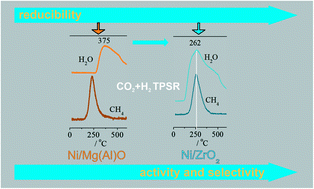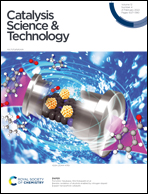The tendency of supports to generate oxygen vacancies and the catalytic performance of Ni/ZrO2 and Ni/Mg(Al)O in CO2 methanation†
Abstract
Ni/ZrO2, Ni/Mg(Al)O, and Ni/SiO2 catalysts were employed in CO2 methanation. The catalysts were characterized by XPS, XRF, XRD (Rietveld refinement method), TPR, EPR, BET, CO2 + H2-TPSR, CO + H2-TPSR, CO2-TPD, CO-TPD, S/TEM-XEDS, and DFT calculations. The catalytic performance of these catalysts in CO2 methanation was analyzed employing a conventional microreactor. CO2 consumption and formation rates of the products were obtained under differential conditions. The Ni/ZrO2 catalyst exhibited the highest activity and selectivity for the methanation of CO2 compared to Ni/Mg(Al)O and Ni/SiO2. The Mg-based catalyst reaches the Ni/ZrO2 performance at high temperatures. Some authors have proposed that CO rupture or formate decomposition (the rate-limiting step of CO2 methanation) occurs on pairs of oxygen vacancy–cus sites. DFT calculations showed that oxygen vacancies improve CO adsorption and dissociation over the Ni/ZrO2 catalyst. For Ni/ZrO2, the vacancies are generated by the insertion of Ni in the ZrO2 lattice (DRX) and by the defects of ZrO2 oxide (EPR), whereas Mg(Al)O shows intrinsic vacancies (EPR). Ni/ZrO2 exhibits the same metallic area compared with Ni/Mg(Al)O. However, the former is more active and selective than Ni/Mg(Al)O at a large temperature range, showing that H2 dissociation is not the rate-limiting step. Indeed, the Zr-based catalyst generates H2O or eliminates oxygen, generating vacancies at much lower temperatures than Ni/Mg(Al)O (CO2 + H2-TPSR and CO + H2-TPSR). However, at higher temperatures (>400 °C), the catalytic behavior of these two catalysts is similar. Indeed, the elimination of H2O and oxygen vacancy formation are easier for both catalysts under these conditions. Thus, this work shows that the catalytic performance of Ni-based catalysts is associated with the support's facility to release O (reducibility).



 Please wait while we load your content...
Please wait while we load your content...